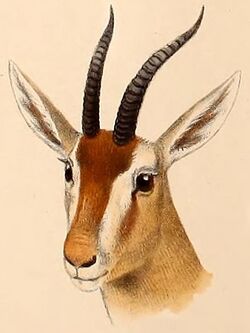Biology:Red gazelle
| Red gazelle[1] | |
|---|---|

| |
| Scientific classification | |
| Domain: | Eukaryota |
| Kingdom: | Animalia |
| Phylum: | Chordata |
| Class: | Mammalia |
| Order: | Artiodactyla |
| Family: | Bovidae |
| Subfamily: | Antilopinae |
| Tribe: | Antilopini |
| Genus: | Eudorcas |
| Species: | E. rufina
|
| Binomial name | |
| Eudorcas rufina (Thomas, 1894)
| |
| Synonyms | |
|
Gazella rufina | |
The red gazelle (Eudorcas rufina) is an extinct species or subspecies of gazelle. It was formerly considered a member of the genus Gazella within the subgenus Eudorcas before Eudorcas was promoted to a full genus. It is thought to have lived in the better-watered mountain areas of North Africa rather than in deserts, because of the rich colouring on the coat.
There are no records of the red gazelle in the wild.[2] It is known from three specimens purchased in markets in Algiers and Oran, northern Algeria, in the late 19th century. They are held in museums in Paris and London. Some authorities, such as Jonathan Kingdon, consider it a subspecies of the red-fronted gazelle (E. rufifrons or G. rufifrons).[3] In 2008, K. de Smet reported one of the three specimens had proved on examination to be E. rufifrons, leading the IUCN Red List to revise its assessment of the species from Extinct to Data Deficient on the basis of doubts as to the validity of the taxon.[2] The red-fronted gazelle occurs in the Sudanian savanna ecoregion, south of the Sahara. The red gazelle occurred north of the Sahara, thereby representing a distinct population irrespective of its species or subspecies status.
Physical characteristics
The red gazelle is described as larger than the red-fronted gazelle, with heavier hooves, and distinctive bright red-brown fur. It is characterized to have thin (2.5–4 cm wide) black stripes across its flanks, in between its rear and front legs. The top of the head, cheeks, and sides of the neck are a pale whitish color, while the undersides and rump are a plain white colour. The center of its face is bordered on both side by pale streaks running from the eyes to the snout. It has a rufous tail with a black tip.[4]
References
- ↑ Grubb, P. (2005). "Eudorcas rufina". in Wilson, D.E.; Reeder, D.M. Mammal Species of the World: A Taxonomic and Geographic Reference (3rd ed.). Johns Hopkins University Press. pp. 637–722. ISBN 978-0-8018-8221-0. OCLC 62265494. http://www.departments.bucknell.edu/biology/resources/msw3/browse.asp?id=14200547.
- ↑ 2.0 2.1 2.2 IUCN SSC Antelope Specialist Group (2008). "Eudorcas rufina". IUCN Red List of Threatened Species 2008: e.T8974A12944313. doi:10.2305/IUCN.UK.2008.RLTS.T8974A12944313.en. https://www.iucnredlist.org/species/8974/12944313. Retrieved 24 December 2017.
- ↑ Kingdon, Jonathan (1997). The Kingdon Field Guide to African Mammals. San Diego: Academic Press. pp. 411–412. ISBN 0-12-408355-2. https://archive.org/details/kingdonfieldguid00jona/page/411.
- ↑ Huffman, Brent. "Eudorcas rufina, Red Gazelle." Ultimateungulate. Ultimateungulate, 20 Feb 2013. Web. 22 April 2013. http://www.ultimateungulate.com/Artiodactyla/Eudorcas_rufina.html
Further reading
- Flannery, Tim; Schouten, Peter (2001). A Gap in Nature: Discovering the World's Extinct Animals. Atlantic Monthly Press, New York. ISBN 0-87113-797-6. https://archive.org/details/gapinnature00timf.
Wikidata ☰ Q942374 entry
 |


